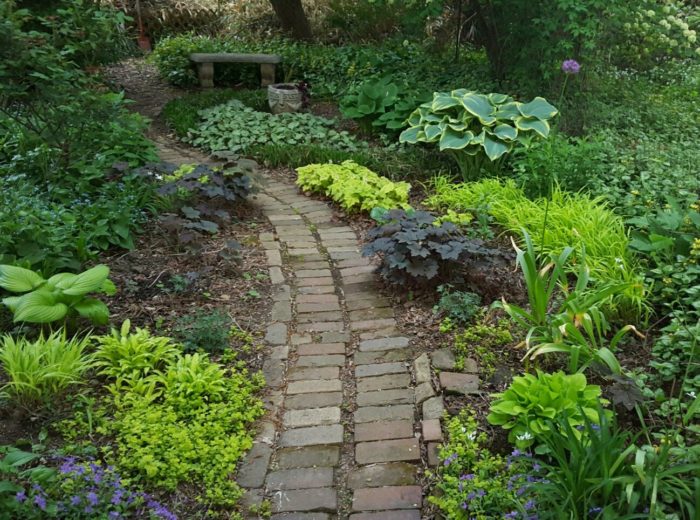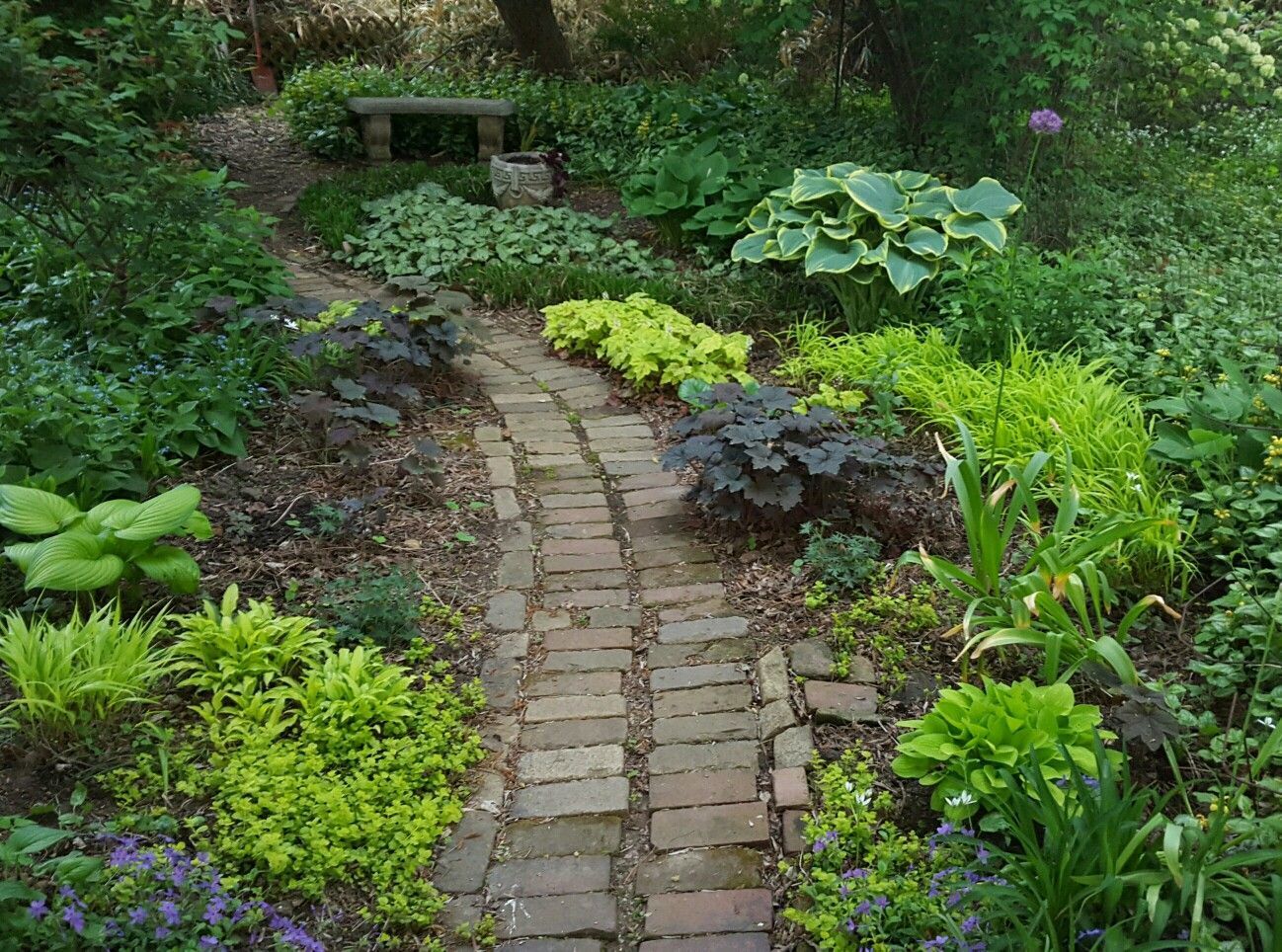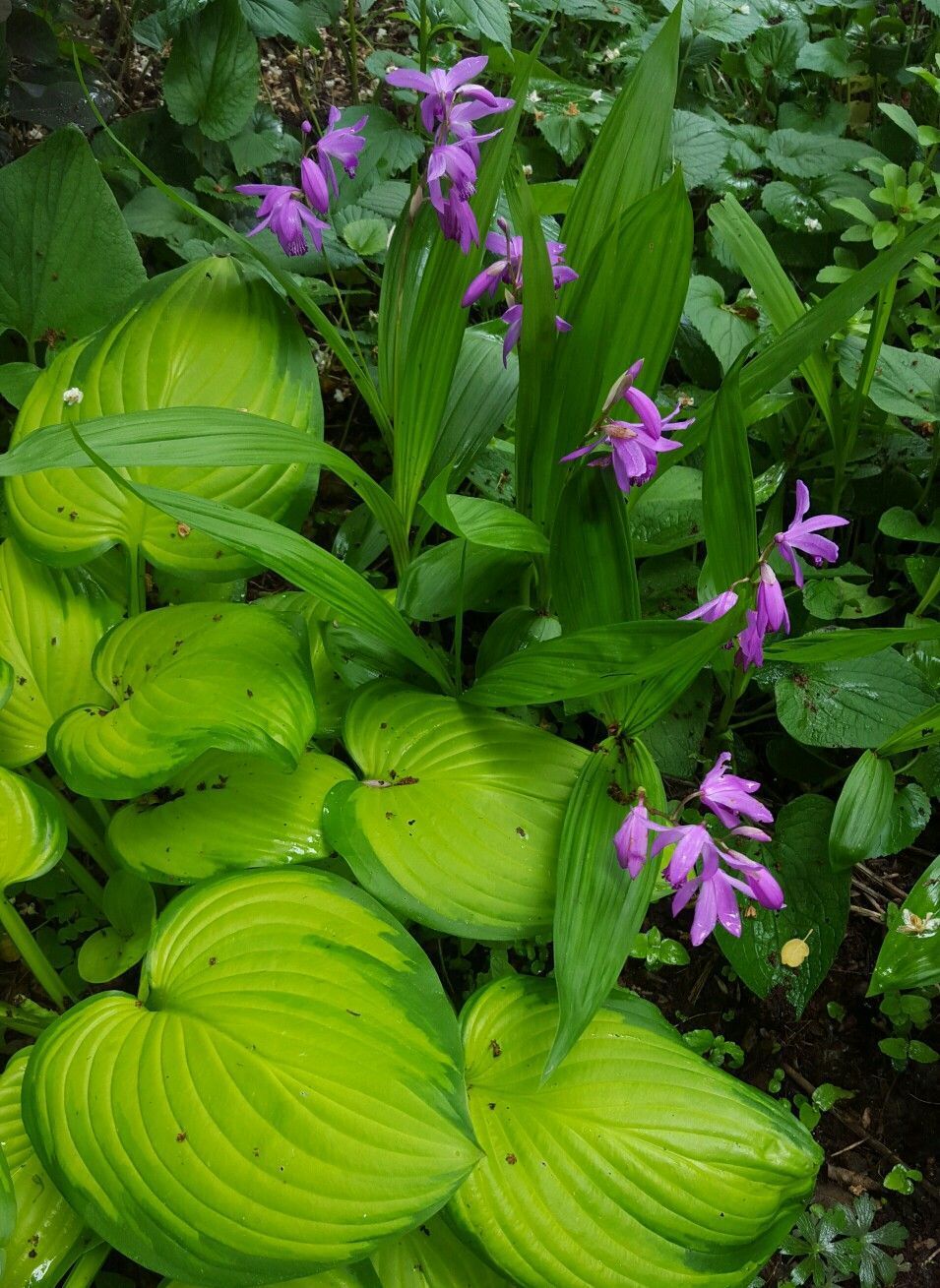Today we’re visiting the garden of Eric Sternfels.
I garden in Northwest Philadelphia in a backyard shade garden that is 18 feet wide by 150 feet deep. With only some turkey-wire fencing separating me from neighbors, the yard does not feel too constricted within this enclave of mill workers’ housing, ca. 1840s. These photos are highlights taken between 2015 and 2018, but I have been developing this garden since 2002.
A small, shady garden may seem like a limitation, but Eric has filled this space with beauty, as you can see here in this path lined with contrasting shades of foliage early in the year.
Bletilla striata (
hardy ground orchid, Zones 5–8) shows off in front of
Hosta ‘Stained Glass’ in mid-May.
Saxifraga stolonifera (Strawberry geranium, Zones 6–9) creates a cloud of airy blossoms in early May and has beautiful, evergreen, silver-marked leaves all year.
This concrete urn is visible in the background of the previous image. Its appearance was improved by burying its clunky base in pea gravel so that the bowl form appears to land gracefully on the ground. Bright white patterned leaves of a caladium (
Caladium sp., Zones 9–11 or as annuals) brighten up this shady area, and under the caladium is an African violet (
Saintpaulia sp.). We’re used to thinking of African violets as houseplants, but clearly they make the transition to a flower annual for shade just fine!
In early October,
Hosta ‘Patriot’ is yellowing while
Tinantia pringlei (Zones 6–10) is producing a cloud of blue-violet blooms that will continue until a hard frost. At right,
Kirengeshoma koreana (Korean waxbells, Zones 5–8) shows its elegant form in front of forsythia (
Forsythia × intermedia, Zones 5–9) shrubs.
A garden can completely transform at different times of the year. Here is the same forsythia from the previous photo, but instead of being green and surrounded by perennials, the forsythia is taking center stage in full bloom while the perennials are still mostly dormant.
A March snowstorm surprises the forsythia in bloom.
Check back tomorrow for part 2 of this wonderful garden!
Have a garden you’d like to share?
Have photos to share? We’d love to see your garden, a particular collection of plants you love, or a wonderful garden you had the chance to visit!
To submit, send 5-10 photos to [email protected] along with some information about the plants in the pictures and where you took the photos. We’d love to hear where you are located, how long you’ve been gardening, successes you are proud of, failures you learned from, hopes for the future, favorite plants, or funny stories from your garden.
If you want to send photos in separate emails to the GPOD email box that is just fine.
Have a mobile phone? Tag your photos on Facebook, Instagram or Twitter with #FineGardening!
You don’t have to be a professional garden photographer – check out our garden photography tips!
Do you receive the GPOD by email yet? Sign up here.
Fine Gardening Recommended Products
Pruning Simplified: A Step-by-Step Guide to 50 Popular Trees and Shrubs
Fine Gardening receives a commission for items purchased through links on this site, including Amazon Associates and other affiliate advertising programs.
Pruning Simplified shows you exactly how to do it. This must-have guide offers expert advice on the best tools for the job, specific details on when to prune, and clear instructions on how to prune. Profiles of the 50 most popular trees and shrubs—including azaleas, camellias, clematis, hydrangeas, and more—include illustrated, easy-to-follow instructions that will ensure you make the right cut the first time.
ARS Telescoping Long Reach Pruner
Fine Gardening receives a commission for items purchased through links on this site, including Amazon Associates and other affiliate advertising programs.
Telescopes from 4 to 7'. Cut and Hold (160) Blades. Drop forged blades for unsurpassed long lasting sharpness. Lightweight, 2.3 lbs., for continued use. Perfectly balanced for easy pruning.
Black and Decker 22-inch Cordless Hedge Trimmer
Fine Gardening receives a commission for items purchased through links on this site, including Amazon Associates and other affiliate advertising programs.
Quick and easy to put into operation and is less noisy and lighter in weight than gas-powered hedge trimmers.
- 38 x 7 x 7 inches
- 6.9 pounds
- 1 Lithium Ion battery required (included)





























Comments
Two things I'd like to add about MY garden:
The first image shows my experiment, successful I think, in ganging together chartreuse leafed perennials to form what appears to be a halo of sunshine in a slightly more open area.
Too often we are told to insert contrasting leaves more haphazardly but the yellows together create a lighting illusion
The African violets are helped from being overwatered in this climate by remaining in their plastic pots and in hot summer, they are watered less frequently than other items in the same planter.
Loved each and every photograph. Just an amazing garden, every part of it. Well done!
Sandy Prowse
Toronto Canada
I am amazed by what you have done in a narrow space. It appears that there is secluded seating behind a tree trunk, hidden from the main path. It also looks like the curves in the path work to hide some areas that don't become visible without going further along. Well done! I also like your use of foliage plants. Too many shade gardens are mono cultures of hosta, but you have planted different perennials to achieve a lovely scene.
I don't see enough true mono cultures of ONE variety of hosta. Usually, its a full assortment pack of every variety stuffed together. Dividing them regularly to create a drift of one cultivar makes the flowers a more welcome event
A beautiful garden. I particularly enjoyed the diversity of shade plants and how you have placed them. Can't wait until tomorrow to see the rest of the garden.
Dale,
Michigan
Thanks, Dale
Lots of my plants have been gifted divisions from a great local network of garden lovers here. And I divide and spread them over more territory to form linear drifts to help move the eye through this linear garden
Love the diversity of not only color, but shape and height. The curves create soften the lines, and beckon us to enter and explore. Thank you. Inspiring.
both curved lines and recycled, earthy materials like broken brick and local stone really make for forgiven relaxed gardens that seem to accept less fastidious maintenance
I sometimes break the rules that are suggested for perennial borders where plants are tiered in height - tallest at the back and shortest in the front. When plants have a lovely form, you can accentuate that by planting them in a low ground cover that allows that form to be best appreciated.
Good morning, Eric. You have certainly developed a beautiful shade garden and your inclusion of the more chartreusy colored plants is very effective...seeming to provide little pools of kisses from the sun. I'm quite charmed by the different small flower ground covers you have and hope to remember their names when spring shopping time comes around.
Thanks, Michaele
If you use Pinterest, click the icon and I think you'll link to my stash of labelled photos so you can recall those names if you forget them.
Love your Bletilla striata. Mine passed away last year & at the local nursery where I shop theirs did too. Your Saxifraga stolonifera is enchanting. I need to look for that one.
Here in Philadelphia, the Bletilla can take more sun than the books suggest. We have indeed have rough winters where it diminishes, but it's so exotic that it's worth piling on a blanket of mulch to help it make it to a new season
Congratulations, Eric, this is a fantastic accomplishment! Love your garden! I wanted to add that Bletilla striata is hardy up here in the Detroit area. I have mine on the north east side of my garage, so it's protected from the west wind. I don't do anything special for it, no mulch or anything like that. It gets plenty of water, though, so maybe that's the secret.
I suspect that it may be about adequate drainage in snowy winters with lots of freeze-thaw cycles rather than low temperatures, but I am not sure.
Special thanks to the GOPD editor for selecting photos in a sequence that each link the images together. They really tell a story better by that sensitivity. Can't wait to see which additional photos you select for the second installment!!!
I find that the Saxifraga looks absolutely best in full but bright shade. With some direct sun, especially in the afternoon, the leaves curl just a bit.
Love that curvy path sauntering off into the furtherest back portion of your lot. The idea of burying the bottom of the urn was a good one. So many times they look as though they were too thoughtfully placed. This one looks almost as though a wayward "urn plant" seeded itself in just the right spot to show off its current inhabitants among the natives.
the base on that pot was particularly clunky. And the moss-covered vintage bricks containing the pea gravel are the "fiddlehead" terminus of the serpentine path which gets ever narrower using a pile of broken bricks. In winter a gently curved line in the garden, whether path or bed edging really can add some elegance.
also, lowering the pot made for better sight lines with the concrete bench behind it!
Looking forward to tomorrow's photos of this marvelous garden. I am officially in love with the strawberry geranium!
Eric, I am belatedly adding my kudos for your wonderful garden. And am officially joining the fans of the strawberry geranium - I'll have to see if it can handle the humid summers here in SW Missouri, but, as I recall, Philadelphia summers are pretty humid as well! Can't wait for tomorrows pictures!
Funny thing about that Saxifrage (occasionally called Strawberry Begonia in addition to Strawberry Geranium) is that I don't see it for sale as a hardy perennial. It's quite often available as a houseplant in a hanging basket (with its strawberry like runners trailing from the pot) from Lowe's or Home Depot. I brought some inside last winter and had it flowering in late February through April with its odd, dainty little flowers
And it continuously sends out its runners, forming tiny new plants all during prime growing season. Give it some good amount of territory and keep transplanting more to fill any bare spots. That's the way to achieve that ethereal cloud of blooms. They otherwise look a bit weedy when not en masse.
thanks so much for posting! I gardened in Texas for years and now that I'm in Ohio, I am finding these kinds of posts invaluable for finding cool plants and getting advice on how to grow them. I've seen the Bletilla at fancy gardens but never knew what it was called. Have to find some!
Believe it or not, Bletilla would be worth growing simply for it's beautiful leaves/blades which are a great contrasting texture to the many smaller-scaled foliage more common among shade plants. They turn yellow => gold in the fall. If pollinated, the orchid flowers will also develop lovely pods on zig-zag stems…… a real show-stopper.
So natural and inviting, and nice to see the different looks of different seasons. Just beautiful!
I really like this gardening. Soo beautiful!
I am so glad you commented on that Strawberry Geranium. I was thinking that it used to be a very popular house plant years ago and than I thought "no it can't be, but it IS!" Wow, so cool looking. I'll have to check it out. Thank you for sharing your garden with us.
Log in or create an account to post a comment.
Sign up Log in